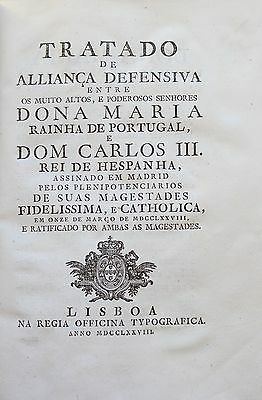 | ||
The Treaty of El Pardo was signed on March 11, 1778 between Queen Maria I of Portugal and King Charles III of Spain. The treaty aimed at resolving long-standing territorial disputes arising from non-observance of the terms of the Treaty of Tordesillas and subsequent treaties to resolve the matter.
Contents
South America
The most recent points of contention between the two parties arose from the Portuguese advance into the region of the Misiones Orientales and present-day Uruguay and parts of Paraguay, as well as unresolved issues stemming from the Spanish–Portuguese War, 1761–1763 and the Spanish–Portuguese War, 1776–1777.
The main issue was the penetration by Portuguese Bandeirantes deep into the South American hinterland, in violation of the division imposed by the Treaty of Tordesillas. The new treaty recognised the principle of uti possidetis, already followed in earlier treaties. However, doing so recognised Portuguese dominion over vast swathes of present-day Brazil, whereas the Spanish had stayed out of Africa in observance of the Treaty of Tordesillas.
Central Africa
To compensate for this imbalance, Queen Maria agreed to cede the islands of Annobón and Bioko (Fernão Pó) to King Charles, as well as the Guinea coast between the Niger River and the Ogoue River. The island of Bioko (named Fernão do Pó during Portuguese rule) was officially renamed and recognized as Fernando Poo.
